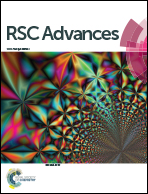A confinement of N-heterocyclic molecules in a metal–organic framework for enhancing significant proton conductivity†
Abstract
A series of N-heterocyclic⊂VNU-23 materials have been prepared via the impregnation procedure of N-heterocyclic molecules into VNU-23. Their structural characterizations, PXRD, FT-IR, Raman, TGA, 1H-NMR, SEM-EDX, and EA, confirmed that N-heterocyclic molecules presented within the pores of parent VNU-23, leading to a remarkable enhancement in proton conductivity. Accordingly, the composite with the highest loading of imidazole, Im13.5⊂VNU-23, displays a maximum proton conductivity value of 1.58 × 10−2 S cm−1 (85% RH and 70 °C), which is ∼4476-fold higher than H+⊂VNU-23 under the same conditions. Remarkably, the proton conductivity of Im13.5⊂VNU-23 exceeds the values at 85% RH for several of the reported high-performing MOF materials. Furthermore, Im13.5⊂VNU-23 can retain a stable proton conductivity for more than 96 h, as evidenced by FT-IR and PXRD analyses. These results prove that this hybrid material possesses potential applications as a commercial proton exchange membrane fuel cell.



 Please wait while we load your content...
Please wait while we load your content...